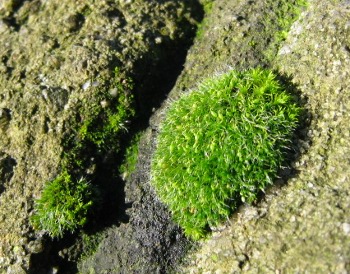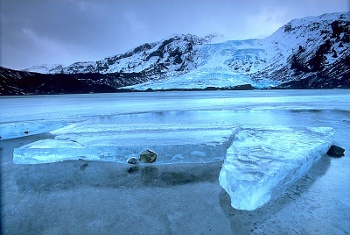
Ordovician Carbon Sinks
February 28, 2012 Although Lovelock's Gaia hypothesis might be a little too heavy on philosophy and light on actual science, there's no question that the presence of living organisms has shaped Earth's environment. It's also true that Earth's biosphere owes its particular composition to the handy symbiosis between plant and animal metabolism. Plants take in CO2 from the atmosphere and create oxygen. Animals breathe O2 and exhale CO2. Aside from a large dose of anthropogenic carbon dioxide, the atmosphere seems to regulate itself quite well, perhaps because of control mechanisms like those postulated by the Gaia hypothesis. In the long history of the Earth, things weren't always that way. There was a time when there were few plants on Earth' surface. Then, about 450 million years ago, plant life began to cover the Earth during the Ordovician period. These early land plants were primitive, non-vascular mosses, probably evolved from green algae. | Moss growing on a dry stone fence. Primitive mosses were the first land plants. (Photo by P. Smith, via Wikimedia Commons). |
 | One way to check your browser's fonts - The Icelandic language. Gígjökull, an outlet glacier extending from Eyjafjallajökull, Iceland. (Photo by Andreas Tille, via Wikimedia Commons). |
"For me the most important take-home message is that the invasion of the land by plants – a pivotal time in the history of the planet - brought about huge climate changes. Our discovery emphasizes that plants have a central regulatory role in the control of climate: they did yesterday, they do today and they certainly will in the future."[3]However, lest we think that planting more trees in the Amazon rainforest will solve all our global warming problems, lead author, Tim Lenton, cautions that "...It would take millions of years for plants to remove current carbon emissions from the atmosphere."[3] An editorial in the same issue of Nature Geoscience in which this research was published brings us back to the Gaia hypothesis mentioned at the beginning of this article. The editorial remarks that many exoplanets are being discovered, but it's not just Earth's size and orbit from its sun that makes it "Earthlike." Plants have modified Earth's atmosphere, land surface and oceans far beyond what the planet looked like early in the Ordovician.[6,7]
References:
- Sid Perkins, "Did Plants Freeze the Planet?" Science Now, February 1, 2012.
- Timothy M. Lenton, Michael Crouch, Martin Johnson, Nuno Pires and Liam Dolan, "First plants cooled the Ordovician," Nature Geoscience, vol. 5, no. 2 (February 1, 2012), pp. 86-89.
- First plants caused ice ages, University of Exeter Press Release, February 1, 2012.
- First land plants may have plunged the Earth into a series of ice ages, Guardian (UK), February 1, 2012.
- Rob Waugh, "The arrival of the first plants cooled the planet so much that it triggered a series of ice ages," Daily Mail (UK), February 1, 2012.
- Editorial - One and only Earth, Nature Geoscience, vol. 5, no. 2 (February 1, 2012), p. 81.
- Mark Fischetti, "Thanks to Plants, We Will Never Find a Planet Like Earth," Scientific American, February 1, 2012.
- Timothy M. Lenton, Michael Crouch, Martin Johnson, Nuno Pires and Liam Dolan, "First plants cooled the Ordovician," Nature Geoscience, vol. 5, no. 2 (February 1, 2012), pp. 86-89.